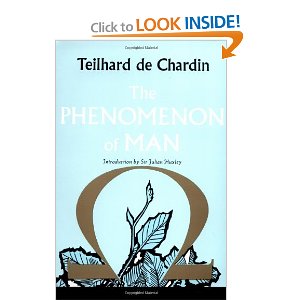
Pierre Teilhard de Chardin
5.0 out of 5 stars The Theory of Global Human Consciousness
May 7, 2005
By “Patrick” (Los Angeles, Ca.) – See all my reviews
Pierre Teilhard de Chardin (1881-1945) was a Jesuit Priest, theologian, philosopher, and paleontologist who expanded on the concept of the noosphere originated by the Russian mineralogist and geochemist, Vladimir I. Vernadsky (1863-1945) who also originated the concept of the biosphere- the “life zone” where all biological life exists between the crust of the earth to the lower atmosphere or the “life envelope” surrounding our planet.
The “noosphere” or “thinking layer”, according to Chardin, comes about at that point in time when humans evolve to the realization of a global human consciousness and is totally aware of itself and then headed for the ultimate destination- the “Omega Point” or “Kingdom of God”. At this point, the earth is enveloped by a collective human consciousness.
Chardin uses both science and theology to support this theory and his dissertation on this is fascinating and thought provoking. Unlike most of his religious peers, he was a proponent of directional evolution and that Darwin had hit upon the proof of God's intent, that final destination of the human conscious evolution where the Creator is realized. Darwin, of course, preferred to distance himself from theological assumptions of species evolution, especially so with us humans and his religious wife.
Chardin distinguishes humans from all other life-forms because of our abilities to contemplate our existence, hence, the uniqueness of or the “phenomenon of man”. Hopefully, he concludes, that the human family will evolve to be totally conscience, intelligent and loving, cooperative, and rising far above our current chaotic existence. Amen to that lofty, but desirable goal!
The evolutionary path of the noosphere is laid out in Chardin's earth evolution and stated as: “We have been following the successive stages of the same grand progression from the fluid contours of the early earth. Beneath the pulsations of geo-chemistry, of geo-tectonic and of geo-biology, we have detected one and the same fundamental process, always recognizable-the one which was given material form in the first cells and was continued in the construction of nervous systems. We saw geogenesis promoted to biogenesis, which turned out in the end to be nothing less psychogenesis.” (p 181). And leading therefore, to “noosgenesis” or global consciousness. Finally, and due to the interconnectedness and seemingly intentional direction of life on earth, Chardin gives Earth a soul: Gaia thinking- Earth “intentionally” supports life.
No wonder then that Chardin is referenced and quoted in a mountain of science and religious works. His theories have influenced such great thinkers as: Lewis Thomas (“The Lives of a Cell”), Buckminster Fuller (“The Dymaxion Map”), the Gaia Theory- Earth as a conscious, intentional, self-regulating life-support system and expounded upon by Guy Murchie (“The Seven Mysteries of Life”) and later by James Lovelock (Gaia: The Practical Science of Planetary Medicine”), Thomas Berry (“The Dream of the Earth”) and many, many more.
Chardin traveled the world on his scientific investigations and he was present at the discovery of the Peking Man in China. Some historians have intimated that much of Chardin's travels were at the behest of the Catholic Church for they were not thrilled with his attempts to blend science and religion and the farther away from Rome he was, the better.
The church cautioned him not to publish any of his works and faithful to that edict, he left them to a friend in the U.S. to publish posthumously to avoid further conflict and retaliation from the Church- bad memories of the history of the Catholic Church's terrible treatment of scientist and thinkers whose musings drifted from repressive, suffocating church dogma, i.e., Galileo Galilei, et al.
No matter where one's leanings are on religion or science, this is a potent dissertation on bringing science and religion together for awe and respect of life and eventual peace on Earth through global consciousness.




